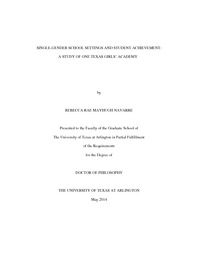
ATTENTION: The works hosted here are being migrated to a new repository that will consolidate resources, improve discoverability, and better show UTA's research impact on the global community. We will update authors as the migration progresses. Please see MavMatrix for more information.
Show simple item record
| dc.contributor.author | Navarre, Rebecca Rae Mayhugh | en_US |
| dc.date.accessioned | 2014-07-14T20:31:12Z | |
| dc.date.available | 2014-07-14T20:31:12Z | |
| dc.date.issued | 2014-07-14 | |
| dc.date.submitted | January 2014 | en_US |
| dc.identifier.other | DISS-12664 | en_US |
| dc.identifier.uri | http://hdl.handle.net/10106/24492 | |
| dc.description.abstract | The purpose of this study was to compare the academic success of female students selected to enter the single-gender school and female students' eligible but not selected to the single-gender school setting. Since single-gender settings are reported to narrow the academic achievement gap of underprivileged students, especially minority inner-city students, this population received additional review. Proponents of single-gender education have argued that boys and girls have different learning styles and need to be educated separately for maximum academic success (Sax, 2010). Single-gender education advocates believe in an equal but separate educational system based on the idea that males and females are fundamentally different and thus have different needs (Sax, 2010; Spielhagen, 2011). Unfortunately, there is no direct evidence that single-gender settings improve outcomes for all students, since nearly all existing single-gender schools are private schools where student backgrounds are quite different from those in most public schools (Billger, 2009). Assessing the advantages and disadvantages of single-gender classes and schools is not only a "complicated question" (Salomone, 2003, p. xi), but also a political one involving education policy makers, politicians, social reformers and parents and college administrators (Jackson, 2002; Salomone, 2006).The student results provided meaningful implications within the field of single-gender education. In addition, implications within the focus of cultural capital were provided. These implications are presented in three sections, including research, theory, and practice. Knowing that students from minority, low socioeconomic groups are falling farther behind the White, non-economically disadvantaged students, the results of this study indicate the need to continue to research this setting. Based upon this study, it seems prudent to look at the single-gender setting specifically as a way for this grouping to raise student achievement. Specifically, knowing that students from minority and economically disadvantaged/low socioeconomic backgrounds are particularly at risk of failing, this research is timely and valuable. | en_US |
| dc.description.sponsorship | Hyle, Adrienne E. | en_US |
| dc.language.iso | en | en_US |
| dc.publisher | Education | en_US |
| dc.title | Single-gender School Settings And Student Achievement: A Study Of One Texas Girls' Academy | en_US |
| dc.type | Ph.D. | en_US |
| dc.contributor.committeeChair | Hyle, Adrienne E. | en_US |
| dc.degree.department | Education | en_US |
| dc.degree.discipline | Education | en_US |
| dc.degree.grantor | University of Texas at Arlington | en_US |
| dc.degree.level | doctoral | en_US |
| dc.degree.name | Ph.D. | en_US |
Files in this item
- Name:
- Navarre_uta_2502D_12664.pdf
- Size:
- 342.6Kb
- Format:
- PDF
This item appears in the following Collection(s)
Show simple item record


